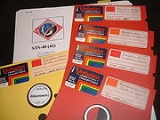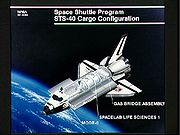
G-616
Encyclopedia
GAS G-616: The Effect of Cosmic Radiation on Floppy Disks

Small Self-Contained Payload G-616 was managed and owned by Thomas M Hancock III a space scientist from Redlands CA.
G-616 was assigned by NASA to Mr. Hancock in 1987. He developed and constructed the primary payload. It was approved for flight by NASA in 1988. G-616 originally consisted of 3 experiments:
1. A study on the effects of low Earth orbit on sympatic (Space Shuttle External Tank) foam.- To asses if leaving a Space Shuttle External Tank in space was feasiable.
2. Static Computer Memroy Integrity Testing (SCMIT)– looking for soft event upsets (bitflips) in static computer media
3. Cultavor Microgravity Exposure (seeds in space). This experiment was to fly over two million seads of 57 types from all over the world to orbit.
Pre flight testing with the Goddard Space Flight Center demonstrated that 24% of the Space Shuttle External Tank Foam sample outgased in 24 hours. This was several 100 times over what was allowed for on orbit opeations. Based on this the experiment was pulled prior to flight. It also answered the basic question. NASA could not leave External Tanks on orbit with creating a significant debirs clod. It also answered the basic question, NASA could not leave External Tanks on orbit without creating a significant debirs.
The other two experiments passed testing and payload safety data reviews in 1989.
In 1989 Mr. Hancock offered the Redlands Unified School District the chance to fly floppy disks and receive over 1.5 million of the flown planets seed for student instruction.
Mr. Hancock worked with every school in the Redlands Unified School District in support if this effort.
The payload was integrated @ KSC in early 1990 and was the 1st Shuttle Small Payload constructed and assembled for flight @ KSC since the loss of the Space Shuttle Challenger in 1986.
Hydrogen leaking from the Space Shuttle main propulsion system delayed launch for over 1 year. During this time the payload was stored on the GAS Bridge Assembly ready for flight @ Hanger AF, NASA/KSC. On June 5th 1991 the payload was launched in the Space Shuttle Columbia as part of the SLS-1 mission (SpaceLab Life Sciences-1).
The payload spent 9 days in orbit landing at Edwards Air Force Base. The payload was recovered @ KSC during 1st week of July 1991. The disks flown for the students as part of Mr. Hancock’s experiment and over 1.5 millions seeds where presented to the Redlands Unified School District in August 1991.
Papers about the experiments where published in the 1988, 1993 and 1999 @ the Shuttle Small Payload Symposiums.
A presentation on the results from both flights of the SCMIT experiment (STS-40 and STS-87) was presented @ the US Naval Academy in 1999 - http://library01.gsfc.nasa.gov/host/hitchhiker/index17.html
and http://library01.gsfc.nasa.gov/host/hitchhiker/SCIMT.pdf
Note: A contest was held within the Redlands Unified School District for a student to develop a logo for this mission. It was flown on the outside of the payload canister during the mission.

